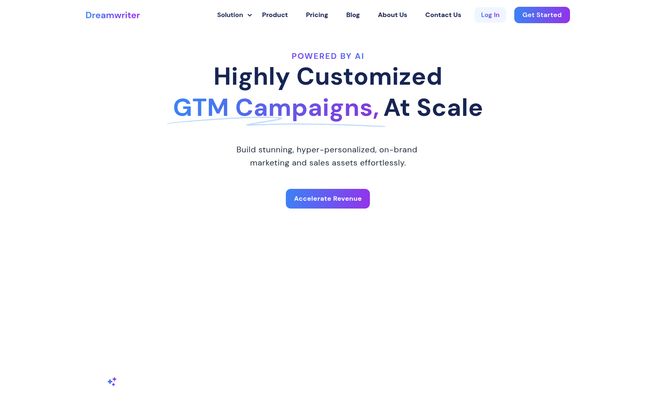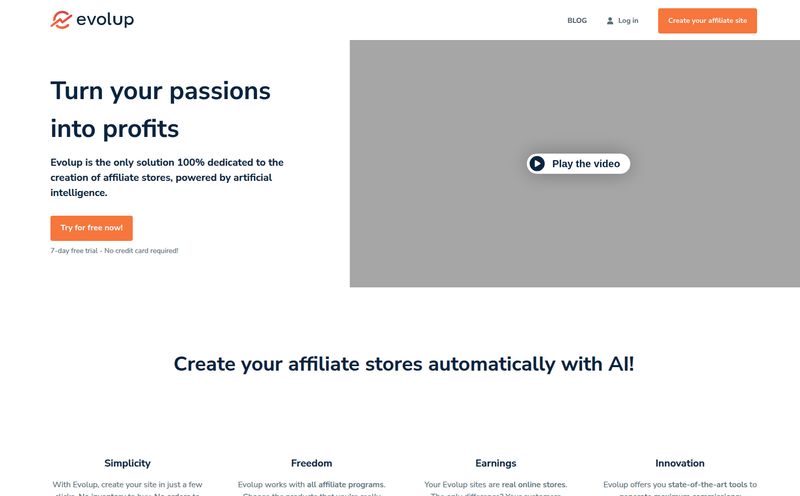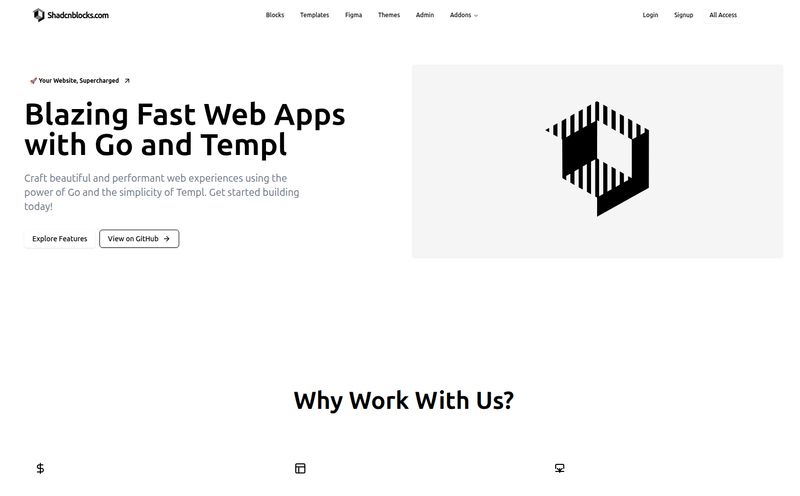Is Dreamwriter the AI Tool Your GTM Team Has Been Waiting For?
The go-to-market (GTM) content grind is... a lot. As someone who’s spent years neck-deep in SEO, traffic gen, and watching CPC costs climb, I've seen the same story play out a dozen times. Marketing painstakingly crafts the 'perfect' campaign. Sales gets it, says 'thanks,' and then goes off and makes their own one-pager in PowerPoint because the official stuff doesn't speak to the person they're calling right now. The result? A mess of off-brand content, missed opportunities, and a whole lot of wasted effort.
We've all been there. It's that constant battle between maintaining brand consistency and enabling your sales team to be agile. For a while, it felt like you had to pick one. But the new wave of AI tools is starting to change that equation. And that brings me to a platform that recently popped up on my radar: Dreamwriter. It claims to create 'highly customized GTM campaigns, at scale.' A big claim. So, naturally, I had to see if it was just another shiny object or the real deal.
What Exactly is Dreamwriter? (And Why Should You Care?)
Think of Dreamwriter not as just another AI text generator, but more like a specialized workbench for your marketing and sales teams. Its whole reason for being is to churn out hyper-personalized, on-brand collateral—think sales decks, one-pagers, case studies, you name it—in minutes, not days. The platform's big idea is that 'static marketing assets are relics of the past,' and I've got to say, I'm inclined to agree. The one-size-fits-all approach just doesn't cut it anymore.
What makes it interesting is its focus. It’s not trying to be a jack-of-all-trades AI like some others. It’s laser-focused on the GTM motion, aiming to be the bridge between the brand guardians in marketing and the front-line soldiers in sales. It's a tool designed to understand your brand, then empower everyone to create materials that are both unique and consistent. A pretty neat trick if they can pull it off.
My Favorite Dreamwriter Features
I’ve tested a lot of AI platforms. A LOT. Most are impressive for a minute, but the novelty wears off when you try to apply them to real work. Here’s where I think Dreamwriter stands out from the crowd.
Brand Voice Amplification: Your AI, Your Rules
This is the big one for me. Getting an AI to not sound like... well, an AI, is the holy grail. Dreamwriter’s approach is to let you 'train' it on your brand's voice, tone, and visual identity. Now, let’s be real, this takes a bit of upfront work. You have to feed it the right stuff. But it’s an investment. You’re essentially creating a digital brand steward that can then be used to guide every piece of content. It’s the difference between renting a generic tool and building a custom asset.
The Magic of Hyper-Personalization at Scale
Personalization is more than just sticking a [First Name] tag in an email. True personalization means speaking to a specific person in a specific industry with a specific problem. The testimonials for Dreamwriter hit on this hard. One user mentioned creating beautifully designed PPTs with 'hard-hitting messaging' for investors in minutes. Another talked about unlocking 'the ability to hyper-target and localize content.' This is the stuff that actually moves the needle on conversion rates. Instead of one generic sales deck, your team can generate ten different versions for ten different prospect profiles before their second cup of coffee. That's a game changer.

Visit Dreamwriter
Bridging the Marketing and Sales Divide
Ah, the age-old cold war between marketing and sales. Marketing says sales doesn't use their materials. Sales says the materials aren't useful. Dreamwriter positions itself as a peace treaty. By setting up the brand guidelines and templates, marketing maintains control over the brand. But then, the sales team is empowered to self-serve, creating the tweaked, personalized collateral they need on the fly. It's collaboration without the constant back-and-forth and approval bottlenecks. This leads to more speed, more relevance, and frankly, fewer inter-departmental headaches.
The Real-World Impact on Your Workflow
Features are nice, but results are what pay the bills. How does a tool like this actually affect your daily operations and bottom line?
- Time and Resource Savings: This is the most immediate benefit. One founder, Cristian Gallardo, said he was spending 4 hours a day creating content and that Dreamwriter helped him create 3x as much. I mean, do the math. That's an incredible amount of time freed up for strategy, client calls, or, you know, having a life.
- Better Conversion Rates: It’s a simple chain of logic. More personalized content leads to higher engagement. Higher engagement leads to better conversations. Better conversations lead to more closed deals. By making personalization easy, Dreamwriter directly impacts your revenue potential.
- Rock-Solid Brand Consistency: For any marketing manager or COO, this is music to your ears. You get the benefits of customized outreach without the brand dilution that often comes with it. Everyone is singing from the same, beautifully designed song sheet.
Let's Talk Money: Dreamwriter Pricing Breakdown
Alright, let's get down to the brass tacks. Is this thing affordable? The pricing structure seems pretty standard for a SaaS tool in this space, with a few different tiers for different needs.
| Plan | Price | Best For |
|---|---|---|
| Starter | Free | Tire-kickers and solo users who want to see what the fuss is about. It's limited, but it's a genuine free tier, not just a trial. |
| Pro | $22 /month (billed annually) | The sweet spot for individual professionals, consultants, or small business owners who are serious about content creation. |
| Teams | $79 /month (billed annually) | Small to medium-sized teams (up to 5 people) who need collaboration features and higher usage limits. This is where the sales + marketing magic really happens. |
| Enterprise & Agencies | Custom | The big leagues. Large organizations or agencies that need unlimited everything, custom integrations (like with your CRM), and premium support. |
My take? The free plan is generous enough to actually let you build something and see if the workflow... works for you. The Pro plan feels very reasonably priced for the power it offers a single user. The value of the Teams plan really depends on how deep your collaboration needs go.
The Not-So-Perfect Parts
No review is complete without a little constructive criticism. No tool is perfect, and its important to know the potential bumps in the road.
First, that initial setup to teach the AI your brand guidelines? It's a real thing. If you're looking for a tool that reads your mind on day one, this isn't it. You have to be willing to put in some initial effort to get the high-quality, on-brand output you want. Garbage in, garbage out, as they say.
There's also the broader philosophical debate about AI and creativity. Some team members might feel that relying on an AI for the first draft reduces their creative input. I tend to see it differently. I think it handles the grunt work, freeing up your best minds for high-level strategy and refining the message, rather than wrestling with formatting in PowerPoint. But it's a conversation worth having with your team.
Finally, some of the really powerful integrations, like connecting directly to your CRM, are reserved for the top-tier Enterprise plan. This is pretty standard practice, but still something to be aware of if you're a smaller team hoping for deep, automated integration.
Is Dreamwriter the Right Tool for You?
So, the million-dollar question. Should you give Dreamwriter a shot?
In my experience, this tool is going to be a home run for B2B companies with dedicated GTM teams, sales enablement managers who are tired of being content bottlenecks, and marketing agencies juggling multiple client brands. If the struggle between brand consistency and sales agility sounds painfully familiar, you're the prime audience.
Who might not need it? If you're a solopreneur or a very small business whose marketing is primarily top-of-funnel content like blog posts or social media, a more general AI writer might be a better fit. Dreamwriter's strength is really in that mid-to-bottom-funnel sales collateral.
A Final Thought
Tools like Dreamwriter represent a shift. They're moving AI from a fun novelty to a specialized, integrated part of the business stack. It’s not about replacing marketers or salespeople; it's about giving them a bionic arm. It automates the tedious so humans can focus on the strategic. Based on what I've seen, Dreamwriter is a serious contender for any team looking to scale their GTM campaigns without scaling their headcount or their headaches. It's definitely worth a spin on the free plan to see if it clicks for your team.
Frequently Asked Questions
- What is Dreamwriter used for?
- Dreamwriter is primarily used by go-to-market (GTM) teams to quickly create personalized and on-brand marketing and sales collateral, such as presentations, proposals, one-pagers, and case studies.
- Is there a free version of Dreamwriter?
- Yes, there is a 'Starter' plan that is completely free. It has some limitations on usage (e.g., number of campaigns and pages per month) but is a great way to test the platform's core functionality.
- Can Dreamwriter match my company's specific brand voice?
- Yes, one of its key features is the ability to be trained on your specific brand guidelines, including voice, tone, and visual identity, to ensure all content it generates is consistent with your brand.
- How is Dreamwriter different from ChatGPT or other general AI writers?
- While tools like ChatGPT are general-purpose, Dreamwriter is a specialized platform built specifically for GTM and sales enablement. It integrates brand controls, team collaboration, and templates designed for creating sales and marketing assets, not just general text.
- Does Dreamwriter support team collaboration?
- Yes, the 'Teams' and 'Enterprise' plans include features for real-time collaboration, allowing marketing and sales teams to work together seamlessly within the platform.
- Is Dreamwriter suitable for agencies?
- Absolutely. The 'Enterprise and Agencies' plan is designed for this use case, offering unlimited members and usage, making it ideal for managing multiple client brands and campaigns.



